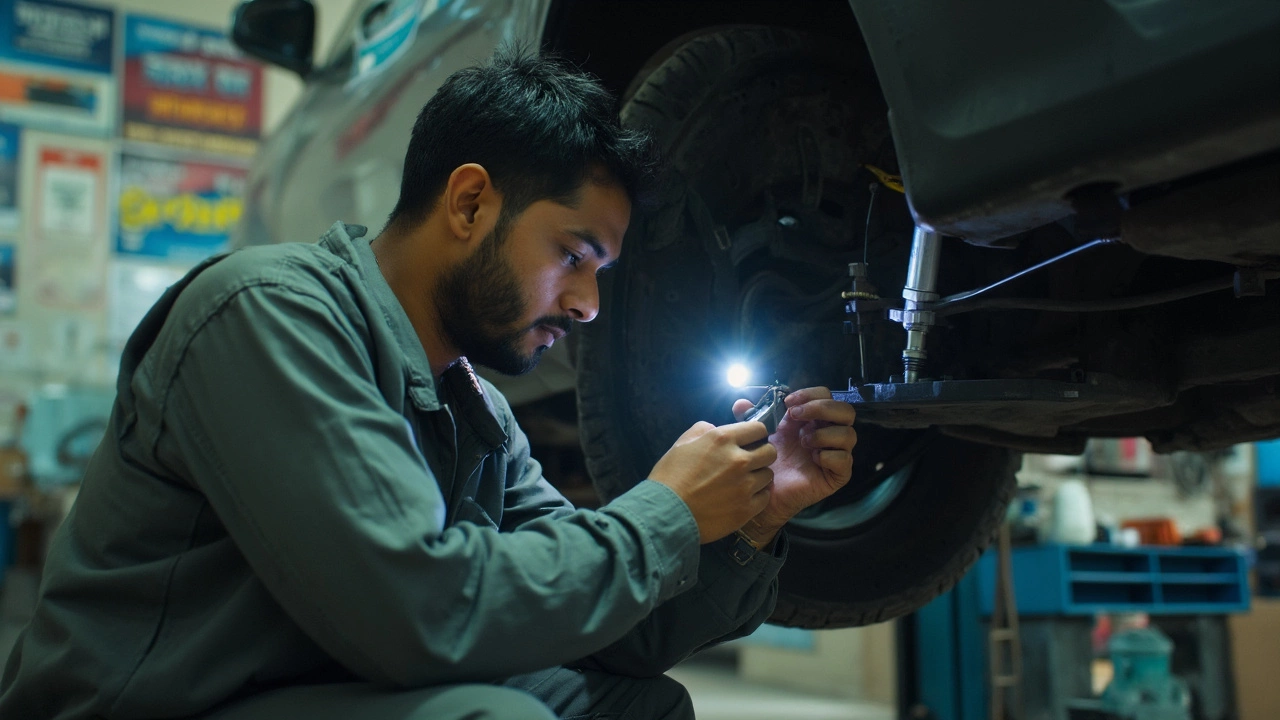Suspension Too Stiff? How to Tell If Your Ride Needs Softer Springs
 May, 9 2025
May, 9 2025
Ever hit a pothole and felt it rattle all the way up your spine? If every bump feels like a punch, your suspension might be too stiff. Lots of folks mess with their suspension hoping for a sportier feel, but end up with a ride that’s jarring and uncomfortable day in and day out.
It’s not just about comfort either—a suspension that’s too stiff can mess with your safety and handling. A car should stick to the road, not hop across it every time you meet a speed bump. Sound familiar? Then it’s time to stop guessing and figure out what’s really going on with your suspension before damaging your back or your car.
- Big Signs Your Suspension Is Too Stiff
- Why Suspension Stiffness Matters
- How to Test Suspension Stiffness Yourself
- Fixes and Tweaks: What Really Works
Big Signs Your Suspension Is Too Stiff
If your car feels more like a go-kart than a daily driver, odds are your suspension is on the stiff side. Not sure? Certain symptoms pop up again and again for folks running a setup that's too tight. It’s not just about rough rides—your whole driving experience can change, for the worse.
The first giveaway: your car crashes over potholes and speed bumps. Instead of absorbing the bump, your suspension just passes the shock straight through to you and your passengers. You might even hear more rattling or creaking inside the cabin, especially over rough roads.
- Stiff suspension signs start with constant jolts. If even regular city streets feel bumpy, take note.
- Excessive tire chatter: watch your front tires on uneven roads. If they keep skipping or losing contact with the ground, that’s a big red flag.
- Poor cornering grip: ironically, going too stiff can make your car less predictable on twisty roads or during emergency maneuvers. You might notice the car feels “skittish” or unsettled.
- Increased cabin noise: knocking, rattling, or plastic creaks can all get worse when your suspension’s not soaking up bumps like it should.
Keep an eye on your back and neck too. If you finish a short trip feeling sore, or your passengers start complaining, don’t just brush it off. That’s your body telling you something’s up.
The last sign that’s easy to miss: uneven tire wear. Super-stiff suspension can’t keep the rubber glued to the road, so tires can wear unevenly or even develop flat spots. That just costs you more money in the long run.
Why Suspension Stiffness Matters
Having the right suspension stiffness is more than just a comfort thing—it’s huge for how your car actually behaves. When folks crank their setup too firm chasing a sportier feel, they often end up making things worse for themselves. Too much stiffness means your tires can lose contact with the road more easily, especially on bad pavement. That can actually make you lose grip when you need it most.
You also get more noise, vibration, and rattling inside the cabin. While you might think a racecar ride is cool, most racetrack setups are terrible for daily use. Most folks don’t realize this, but car manufacturers spend tons of time balancing comfort and performance for real roads—they know drivers want a mix, not a bruised tailbone.
If you’re worried about safety, here’s a wake-up call: a too-stiff suspension can actually make emergency stops longer on bumpy roads. It’s because the tires skip and bounce instead of sticking flat through braking. The data actually backs this up—a 2021 tire and suspension test showed that cars with overly stiff setups needed up to 8% more stopping distance over rough surfaces compared to those with balanced setups.
| Suspension Type | Average Braking Distance (70-0 mph, rough road) |
|---|---|
| Balanced OEM setup | 169 feet |
| Aftermarket, overly stiff | 183 feet |
So you’re not just risking comfort—you’re risking control and safety. The bottom line? Suspension tuning isn’t just for looks or bragging rights. You want a setup that keeps your ride glued to the ground, stays comfortable, and handles whatever your local roads throw at it. Stiffness matters, but balance is the real secret.

How to Test Suspension Stiffness Yourself
There’s no need for fancy tools or a mechanic right away—most folks can figure out if their suspension’s too stiff with just a bit of time and a regular driveway. Here are real steps you can use right now.
- Push-Down Bounce Test: Stand by the front or rear of your car, press down hard on the bumper, and then let go. A healthy suspension should bounce once or twice, then settle. If it barely moves and feels like a solid rock, you’ve probably got a suspension that’s way too stiff.
- Drive-Over-Bump Check: Take your car over a speed bump or pothole at a slow, steady pace. If you feel a sharp jolt or hear something clunking each time, that’s a classic sign the springs or dampers are too firm.
- Tire Contact Test: Look at your tires after a quick drive. If you notice uneven wear, mainly in patches or lines across your tire, your super-stiff setup might be making it tough for the tires to keep in full contact with the road.
- Daily Comfort Check: Pay attention to daily commutes. If your coffee spills or you brace for a hit over rough patches, your suspension could be the culprit. It shouldn’t feel like you’re in a go-kart every day.
If you want to get a bit more detailed, here’s a quick table comparing soft, normal, and stiff suspensions based on common real-world signs:
| Suspension Type | Ride Comfort | Bump Reaction | Tire Wear | Cornering Feel |
|---|---|---|---|---|
| Soft | Very cushy, leans in turns | Absorbs bumps quietly | Even, edges may wear faster | Feels floaty |
| Normal | Balanced, little lean | Bumps heard but not harsh | Even | Predictable grip |
| Stiff | Firm, sometimes harsh | Sharp jolts, rattles possible | Patchy or uneven | Tight, but can lose grip on rough roads |
Keep in mind: if your ride feels off, checking suspension is worth your time. Small fixes now can save your spine (and your wallet) later.
Fixes and Tweaks: What Really Works
If you’re tired of every bump feeling like a brick wall, the good news is you can usually dial things back without spending a fortune. Here’s where to start if you’re sure your suspension stiffness is making your commute miserable.
First, check if your car is running aftermarket springs or shocks. Stiffer parts are common in lift kits or performance setups. If that’s you, the easiest fix might just be swapping back to OEM (original equipment manufacturer) or a known comfort-oriented brand. A lot of people think ‘sport’ means better, but for daily driving, softer usually feels way nicer.
Here’s a quick breakdown of common options and their general effect on comfort and control:
| Part | Comfier Ride | Sportier Feel |
|---|---|---|
| OEM Springs | Yes | No |
| Performance Springs | No | Yes |
| Adjustable Coilovers | Yes (if set soft) | Yes (if set stiff) |
| Stock Shocks | Yes | No |
| Performance Shocks | No | Yes |
If you’re on coilovers, you can usually soften them up by turning the adjustment dial. Some brands have up to 30 clicks of adjustment. Try this:
- Count the number of clicks from your current setting to the softest setting.
- Go soft by 5-10 clicks and drive the same route you use daily.
- If it still feels rough, go even softer—just don’t max out softness if you drive fast on highways.
Don’t forget tire pressure. Sounds basic, but even 3-5 psi above normal can make everything feel way harsher. Double-check your door-sticker for the right number and don’t trust gas station pumps—get a decent gauge.
If you’ve tried the above and your ride is still punishing, take a look at the bushings. Worn or swapped-in polyurethane bushings can add harshness too. Rubber bushings usually give a smoother ride.
Here are a few extra tips if you want a softer drive without turning your car into a boat:
- Go for slightly taller sidewall tires—these eat up little bumps way better than low profiles.
- Stick with wheels close to the stock size. Big rims look cool but kill comfort.
- If you haul heavy loads, match your suspension to the weight—overloaded soft springs bottom out and feel terrible.
- Test one change at a time so you know what actually works.
Most importantly: don’t rely on what random forums say is “best.” Every car and driver has a sweet spot, and sometimes dialing back the stiffness means a lot more comfort, plus better grip than you’d expect.